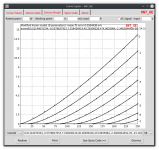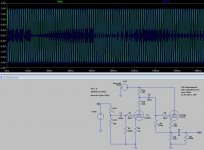Here's one I made with Curve Captor back in 2007:
Might we talk Adrian into modelling one for us...? 
Code:
* 6N7_GE Twin triode power amplifier LTSpice model
* Modified Koren model (8 parameters): mean fit error 0.0594438mA
* Traced by Wayne Clay on 9/6/2007 using Curve Captor v0.9.1
* from General Electric data sheet
* Note: Positive grid region not modeled
.subckt 6N7 P G K
Bp P K I=
+ (0.01144070334m)*uramp(V(P,K)*ln(1.0+(-0.5378627915)+exp((7.018436419)+
+ (7.018436419)*((40.28309326)+(474.9635984m)*V(G,K))*V(G,K)/sqrt((-2.346284445e-05)**2+
+ (V(P,K)-(-24.10402862))**2)))/(7.018436419))**(1.29012841)
Cgk G K 3.0p
Cpk P K 2.5p
Cgp G P 4.5p
Rpk P K 1G ; to avoid floating nodes
d3 G K dx1
.model dx1 d(is=1n rs=2k cjo=1pf N=1.5 tt=1n)
.ends 6N7_GEAttachments
try this:
* 6c5 copy LTSpice model
.subckt 6c5 copy P G K
Bp P K I=(0.02536042149m)*uramp(V(P,K)*ln(1.0+(-0.192595746)+exp((6.112849376)+(6.112849376)*((21.34466788)+(12.4682059m)*V(G,K))*V(G,K)/sqrt((40.12679338)**2+(V(P,K)-(-4.198195652))**2)))/(6.112849376))**(1.286229085)
.ends 6c5 copy
* 6c5 copy LTSpice model
.subckt 6c5 copy P G K
Bp P K I=(0.02536042149m)*uramp(V(P,K)*ln(1.0+(-0.192595746)+exp((6.112849376)+(6.112849376)*((21.34466788)+(12.4682059m)*V(G,K))*V(G,K)/sqrt((40.12679338)**2+(V(P,K)-(-4.198195652))**2)))/(6.112849376))**(1.286229085)
.ends 6c5 copy
try this:
* 6c5 copy LTSpice model
.subckt 6c5 copy P G K
Bp P K I=(0.02536042149m)*uramp(V(P,K)*ln(1.0+(-0.192595746)+exp((6.112849376)+(6.112849376)*((21.34466788)+(12.4682059m)*V(G,K))*V(G,K)/sqrt((40.12679338)**2+(V(P,K)-(-4.198195652))**2)))/(6.112849376))**(1.286229085)
.ends 6c5 copy
Thank you!!! But doesnt work!!!
Looking for 6C5 LTspice working model?? Anyone???
Code:
* ==============================================================
* 6C5 LTSpice model
* Modified Koren model (8 parameters): mean fit error 0.154002mA
* Traced by Wayne Clay on 1/13/2014 using Curve Captor v0.9.1
* from Tung-Sol data sheet
* ==============================================================
.subckt 6C5 P G K
Bp P K I=
+ (0.02259428077m)*uramp(V(P,K)*ln(1.0+(-0.197682911)+exp((6.808001501)+
+ (6.808001501)*((22.3975015)+(57.1203515m)*V(G,K))*V(G,K)/sqrt((15.65144672)**2+
+ (V(P,K)-(-19.06525818))**2)))/(6.808001501))**(1.306693288)
Cgp G P 2.2p ; 0.2p added
Cgk G K 3.2p ; 0.2p added
Cpk P K 11.2p ; 0.2p added
Rpk P K 1G ; to avoid floating nodes
d3 G K dx1
.model dx1 d(is=1n rs=2k cjo=1pf N=1.5 tt=1n)
.ends 6C5Hi. Does anyone have Lt Spice model for soviet 1Ж29Б rod pentode ?
Hi artosano,
Due to changing priorities, I will not be able to finish my 1sh29b model before december.
Perhaps someone else is so kind to generate a model for you?
Kind regards, Adrian
is there a model around for 6C45pi?
This is everything I've collected for 6C45P (6S45P). I don't have any of those tubes, so I can't tell you which (if any) of these are particularly accurate. I understand the tubes themselves have quite variable characteristics, which would make it difficult to create a one-size-fits-most model. Hopefully one of these models will work well enough for you.
Code:
* model by Eugene V. Karpov
*
.SUBCKT 6S45P-E 1 2 3 ; P G C (Triode) 23-Oct-2006
+ PARAMS: MU= 53.57 EX= 1.957 KG1= 126.6 KP= 368.51
+ KVB= 300.0 VCT= 0.00 RGI=1000
+ CCG=11P CGP=5P CCP=1.9P
E1 7 0 VALUE=
+{V(1,3)/KP*LN(1+EXP(KP*(1/MU+(V(2,3)+VCT)/SQRT(KVB+V(1,3)*V(1,3)))))}
RE1 7 0 1G
G1 1 3 VALUE={(PWR(V(7),EX)+PWRS(V(7),EX))/KG1}
RCP 1 3 1G ; TO AVOID FLOATING NODES IN MU-FOLLOWER
C1 2 3 {CCG} ; CATHODE-GRID;
C2 2 1 {CGP} ; GRID-PLATE;
C3 1 3 {CCP} ; CATHODE-PLATE;
D3 5 3 DX ; FOR GRID CURRENT
R1 2 5 {RGI} ; FOR GRID CURRENT
.MODEL DX D(IS=1N RS=1 CJO=10PF TT=1N)
.ENDSFrom Stephie Bench:
Code:
.subckt 6C45-PE 1 2 3 ; plate grid cathode
+ params: mu=47.4501 ex=2.374193 kg1=268.615545 kp=485.735371 kvb=501.503636 rgi=300
+ ccg=2.4p cgp=4p ccp=.7p
e1 7 0 value= {v(1,3)/kp*log(1+exp(kp*(1/mu+v(2,3)/sqrt(kvb+v(1,3)*v(1,3)))))}
re1 7 0 1g
g1 1 3 value= {(pwr(v(7),ex)+pwrs(v(7),ex))/kg1}
rcp 1 3 1g
c1 2 3 {ccg}
c2 1 2 {cgp}
c3 1 3 {ccp}
r1 2 5 {rgi}
d3 5 3 dx
.model dx d(is=1n rs=1 cjo=10pf tt=1n)
.endsAnother one, but I don't remember where I found it:
Code:
* ==============================================================
* 6C45Pi PSpice model
* Joel Tunnah
* ==============================================================
.subckt 6C45Pi-j P G K
Gp P K VALUE=
+ {(0.005984658048m)*limit(V(P,K)*ln(1.0+(0.02028899001)+exp((7.114994862)+
+ (7.114994862)*((56.68678595)+(336.3011671m)*V(G,K))*V(G,K)/sqrt((7.450118654e-006)**2+
+ (V(P,K)-(-10.58802286))**2)))/(7.114994862),0.0,1.0e16)**(1.976888442)}
Cgp G P 4p
Cgk G K 11p
Cpk P K 1.9p
Rpk P K 1G ; to avoid floating nodes
d3 G K dx1
.model dx1 d(is=1n rs=2k cjo=1pf N=1.5 tt=1n)
.ends 6C45Pi-jThis is what I have for WE 437A (You'll need to change "^" to "**" for LTspice):
Code:
* Copyright (C) 2001 Andrei Frolov <andrei@phys.ualberta.ca>
* Distributed under the terms of GNU Public License.
* 437A - IDH miniature high-transconductance Bp P K I=(m)*uramp(()*V(G,K)+V(P,K))^1.5
* From WE 437A datasheet - traced on 24-03-02 by AF
.subckt 437A P G K
Cgp G P 3.8p
Ci G K 11.1p
Co P K 1.0p
* Child-Langmuir law: mean fit error 3.16544 mA
* Bp P K I=(0.08803578596m)*uramp((46.53586861)*V(G,K)+V(P,K))^1.5
* Child-Langmuir law with contact potential: mean fit error 3.13346 mA
* Bp P K I=(0.08984194232m)*uramp((46.41042043)*V(G,K)+V(P,K)+(-1.625595632))^1.5
* Rydel model (4 parameters): mean fit error 2.85294 mA
* Bp P K I=((0.09961070341m)+(0.004497964639m)*V(G,K))*uramp((43.21809681)*V(G,K)+V(P,K)+(-8.460821328))^1.5
* Rydel model (5 parameters): mean fit error 2.5059 mA
* Bp P K I=((0.1072981442m)+(0.003810318087m)*V(G,K))*uramp((46.45918184)*V(G,K)+V(P,K)+(3.803361558))^1.5 * V(P,K)/(V(P,K)+(35.10094748))
* Koren model (4 parameters): mean fit error 2.82829 mA
* Bp P K I=(0.06450876758m)*uramp(V(P,K)*ln(1.0+exp((11.92107695)+(11.92107695)*(46.58588321)*V(G,K)/V(P,K)))/(11.92107695))^(1.566457341)
* Koren model (5 parameters): mean fit error 2.46529 mA
* Bp P K I=(0.0391526539m)*uramp(V(P,K)*ln(1.0+exp((11.13445084)+(11.13445084)*(47.10181935)*V(G,K)/sqrt((2.879020671k)+V(P,K)^2)))/(11.13445084))^(1.667607418)
* Modified Koren model (6 parameters): mean fit error 2.05999 mA
* Bp P K I=(0.04248601694m)*uramp(V(P,K)*ln(1.0+(-0.2031315389)+exp((6.39958427)+(6.39958427)*((43.26744987)+(-942.0790694m)*V(G,K))*V(G,K)/V(P,K)))/(6.39958427))^(1.648729764)
* Modified Koren model (8 parameters): mean fit error 2.03357 mA
Bp P K I=(0.04441361464m)*uramp(V(P,K)*ln(1.0+(-0.08216925584)+exp((6.905076822)+(6.905076822)*((41.36290447)+(-1039.217009m)*V(G,K))*V(G,K)/sqrt((-36.83706712)^2+(V(P,K)-(10.98747878))^2)))/(6.905076822))^(1.639335869)
.ends 437A--
Thanks Ron, appreciated. They take some time to settle when used for the first time, a couple of hours should do it. I'll pick the model with the nearest gm.This is everything I've collected for 6C45P (6S45P). I understand the tubes themselves have quite variable characteristics, which would make it difficult to create a one-size-fits-most model. Hopefully one of these models will work well enough for you.
Something to worry about? And, is there a model around for 6C45pi?
33k cathode resistor for 6S45P is just wasting it's potential. It is best at anode current 20 mA and more.
Yup, just replaced it with 1K. How about the graphic, the dark figure resembles an audiofile. Some sort of oscillation?33k cathode resistor for 6S45P is just wasting it's potential. It is best at anode current 20 mA and more.
Hi guys. I'm trying to simulate a 6L6 single ended output stage. I've been told I should be able to get 12W out of it, but using the models here I can't get past 6W.
I'm using the 6L6.inc model from Ayumi, but also tried other 6Lx6's to no avail.
Here's a screenshot of the test circuit. I simply increased the input voltage amplitude till I reached 6% THD at the output, and then measured the output power. Am I missing something obvious here, please?
ETA: Sorry, B2 should have been 240V instead, but it doesn't make a difference in the simulation

I'm using the 6L6.inc model from Ayumi, but also tried other 6Lx6's to no avail.
Here's a screenshot of the test circuit. I simply increased the input voltage amplitude till I reached 6% THD at the output, and then measured the output power. Am I missing something obvious here, please?
ETA: Sorry, B2 should have been 240V instead, but it doesn't make a difference in the simulation

Last edited:
I've been told I should be able to get 12W out of it, but using the models here I can't get past 6W.
You have been told something that even the tube manufacturer does not promise.
Look at the tube data here: http://www.mif.pg.gda.pl/homepages/frank/sheets/127/6/6L6G.pdf
Your main problem is far too low plate voltage (293 V).
In the datasheet 10.8 W is got with 350 V at plate (and 15 % THD), with 4k2 load impedance and fixed bias.
You have been told something that even the tube manufacturer does not promise.
Look at the tube data here: http://www.mif.pg.gda.pl/homepages/frank/sheets/127/6/6L6G.pdf
Your main problem is far too low plate voltage (293 V).
In the datasheet 10.8 W is got with 350 V at plate (and 15 % THD), with 4k2 load impedance and fixed bias.
Thanks, artosalo. Much appreciated
Hi. Does anyone have Lt Spice model for soviet 1Ж29Б rod pentode ?
Hi all,
does anybody speak Russian here?
I struggle to find the internal capacitances of the 1sh29b in its data sheet.
And translate.google just failes...
http://www.elektronikinfo.de/techpic/strom/1j29b.gif
thanks
Adrian
- Home
- Amplifiers
- Tubes / Valves
- Vacuum Tube SPICE Models


